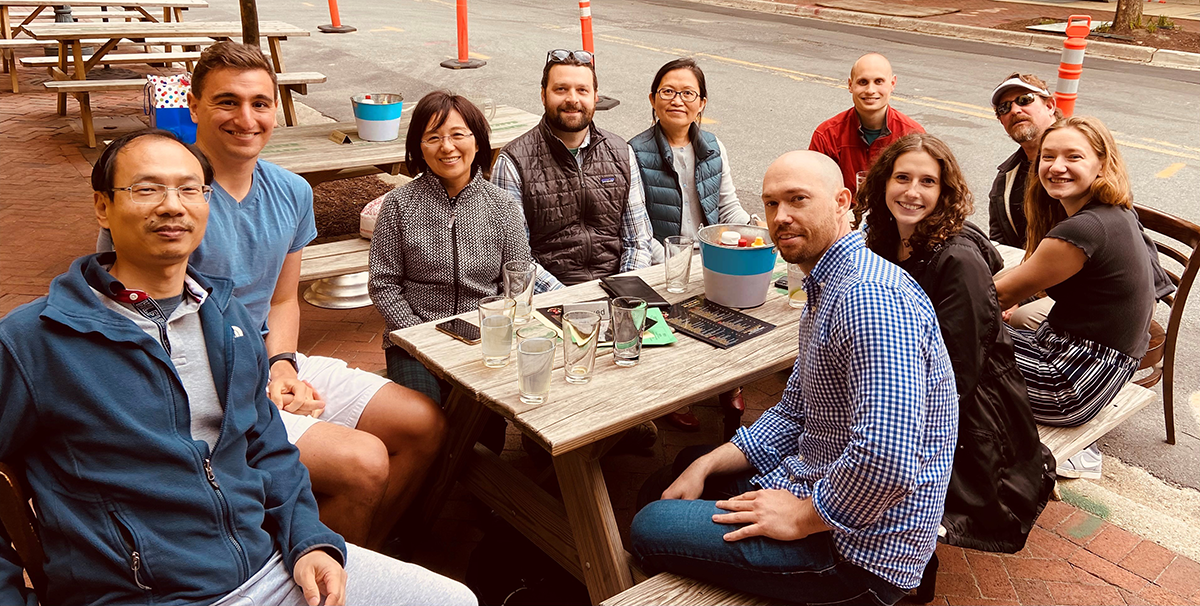I began my training as a postbac at the NIH in August 2020, during the height of the pandemic and consequently a quiet time on campus. With limited people allowed in lab spaces, and in-person interactions kept to a minimum, I was only interacting with one or two fellow researchers on a regular basis for the first year of my training. I felt like the prototypical scientist working alone at the bench.

Thankfully, however, as normal interactions and events are resuming on campus, my experiences as a researcher are slowly changing. Many meetings are happening in person or in hybrid formats; communal areas are busier with chatting colleagues; and I even attended my first in-person lab meeting recently!
These interactions have allowed me to build familiarity with many individuals in my lab, as well as meet new researchers and fellow trainees from outside of my lab. I am quickly learning about the many professional and social benefits of having a community in research. This article will describe some of those benefits, as well as tips for how trainees can develop their own community.

The Hoffman lab enjoying lunch outside. Clockwise from left to right: Jia-Hua Hu, PhD (staff scientist), Adriano Bellotti, MD, PhD (former graduate student), Ying Liu, MD (staff scientist), Jon Murphy, PhD (former postdoc), Lin Lin, MD (staff scientist), Joseph Krzeski (former postbac), Dax Hoffman, PhD (principal investigator), Ashley Pratt (postbac), Maisie Ahern (former postbac), Cole Malloy, PhD (research contractor/postdoc). Photo courtesy of Ashley Pratt.
Forming relationships within the lab
“The first and most important situation in which you will present yourself is to the people in your own laboratory,” writes Kathy Barker, PhD, in her manual At the Bench: A Laboratory Navigator .1 She describes how these are the people that you will rely on the most during your training, and from whom you can learn a lot about research. These individuals know where everything is in your lab and can answer specific questions about the techniques you are using. They are also the individuals who you will see the most.
In my own experience, getting to know my lab mates has made asking questions and seeking help much more approachable. When I don’t know where something is or am confused about a specific technique, it’s nice to know that there are people nearby who can help me.
Additionally, I’ve found support in these relationships and a lot of advice about navigating careers in research. In casual conversations during breaks, the people in my lab have shared insights about navigating graduate school, collaborating, and scientific investigation that have been invaluable to my training. I like to imagine that receiving this advice from experienced colleagues is a lot easier than it would be to learn these lessons on my own.
Getting to know these individuals has also made my work much more enjoyable. It’s fun to come into the lab and have engaging conversations about the research you’re doing. It’s also fun to have people around who you can simply chat about life with. Having this community within my own lab environment makes me feel less like an isolated researcher and more like a part of a team.
Relationships within a lab can often develop organically due to the amount of time you’ll spend with your lab mates. If that’s not the case (say, perhaps, there’s a pandemic…), it’s still possible to foster lab relationships by reaching out to these individuals with questions or inviting them to grab a coffee together (even if it’s six feet apart). Being thoughtful about how you interact with your lab mates can go a long way to facilitating camaraderie within the lab.
Broadening your exposure to different research environments
Even if it feels like there’s an endless source of knowledge within your own lab, there’s a lot that can be gained by connecting with individuals from other research environments. Each lab functions with its own culture, in a way—a unique set of interpersonal and scientific styles and philosophies. Some labs are more social or organized than others, and often labs prefer different techniques. Connecting with individuals outside of your immediate lab can give you exposure to the different roles and environments that exist in research.
In the video “Networking for Scientists (2021),” Amanda Langer, MA, career counselor in the NIH Office of Intramural Training and Education (OITE), recommends that you take time to introspect on what you learn from conversations with other scientists.2 Perhaps that individual’s job sounds appealing to you, or maybe you realize that you wouldn’t enjoy the environment they work in. These insights can help inform your own career goals and decisions.
Networking also exposes you to different scientific questions and techniques being tackled within a field. You never know who might inspire a new project or help solve a problem in your own work. Cole Malloy, PhD, and Meghyn Welch, PhD, researchers in the Section on Neurophysiology, agree that the ideas that emerge from connecting with others is an important benefit of networking. “Like a writer who has writer’s block,” sometimes researchers encounter obstacles that require a new perspective to work through, Dr. Malloy explained. Talking with colleagues and learning about other projects can spark innovative ideas and solutions.
Furthermore, connecting with other researchers is an opportunity to practice talking about your own work. In describing the importance of communication, Dr. Barker writes that “if you can’t communicate your data, they don’t exist.”1 Talking about research with individuals who are within and outside of your area of expertise is a great way to build your science communication skills and receive feedback that can help push your work forward.
From national meetings to small talks within your institution, there are many opportunities to meet researchers outside your own lab. Ms. Langer points out in her video that if you find networking to be daunting, requesting one-on-one meetings or informational interviews can help make the process feel more approachable.2
Building a support system of peers and mentors
Getting to know colleagues in the broader scientific community provides a major source of information, and it can also be a great source of support.
In a recent conversation I had with Erin Walsh, PhD, director of the NICHD Office of Education, she pointed out the value of multiple mentors when making career decisions. Dr. Walsh advised that decisions are ultimately up to the individual, but having input from multiple mentors can provide unique perspectives that you may not have considered otherwise.
Broadening your network of support can also help you access the “hidden job market,” which refers to the high percentage of positions that are filled (or created!) through referrals and connections. Having connections and making good impressions with other researchers increases the likelihood that someone will think of you, or refer you, when a new opportunity or position becomes available.
Finally, connecting with different people in research can make the job more fun! I’ve found that it’s much more enjoyable to attend talks or meetings when there are familiar faces around. Developing relationships in research has been shown to be beneficial to scientific careers. But, in my experience, it also serves to make the job more enjoyable.
References
- Barker, Kathy. (2004). At the Bench: A laboratory Navigator, Updated Edition. Cold Spring Harbor Laboratory Press.
- Langer, Amanda. “Networking for Scientists.” YouTube Video. 51:49. October 22, 2021.https://www.youtube.com/watch?v=F0dtHQ3PmlY .
